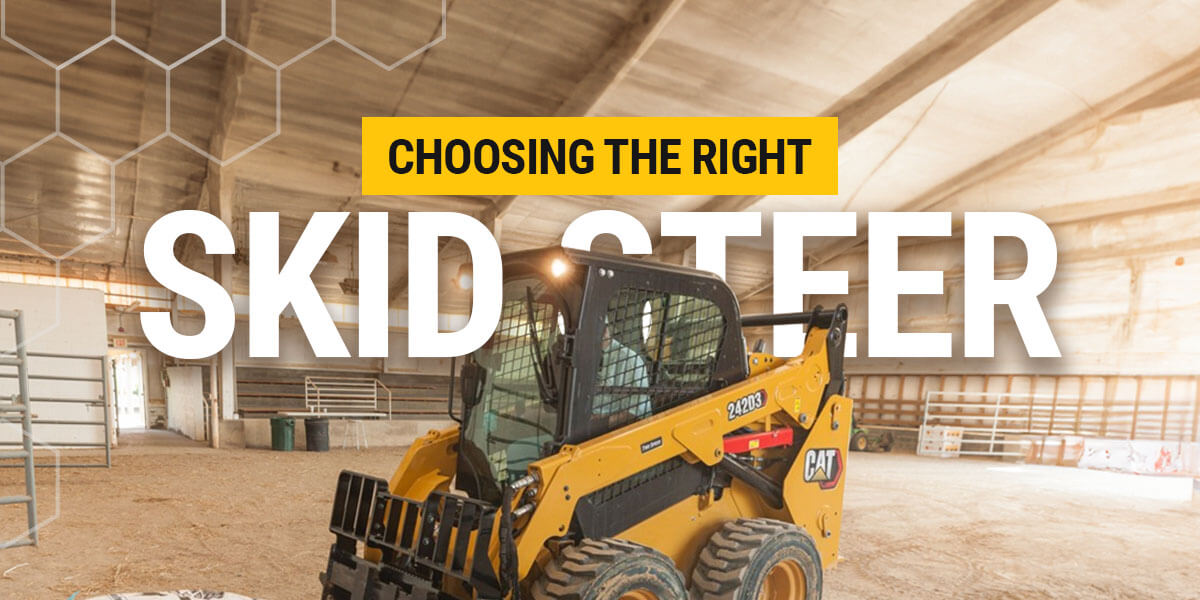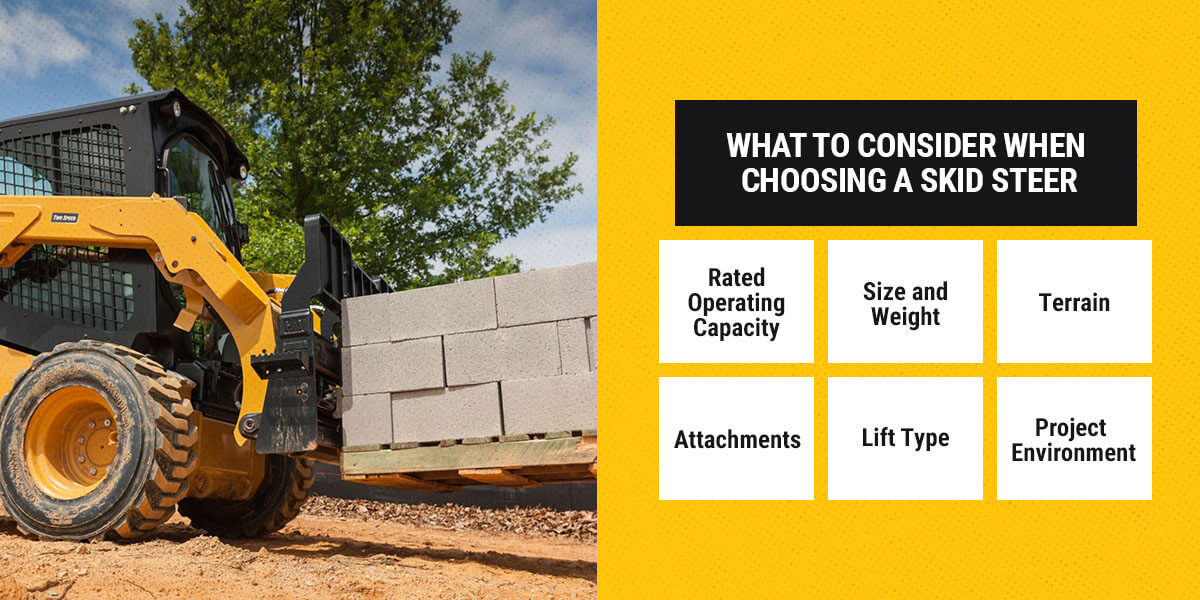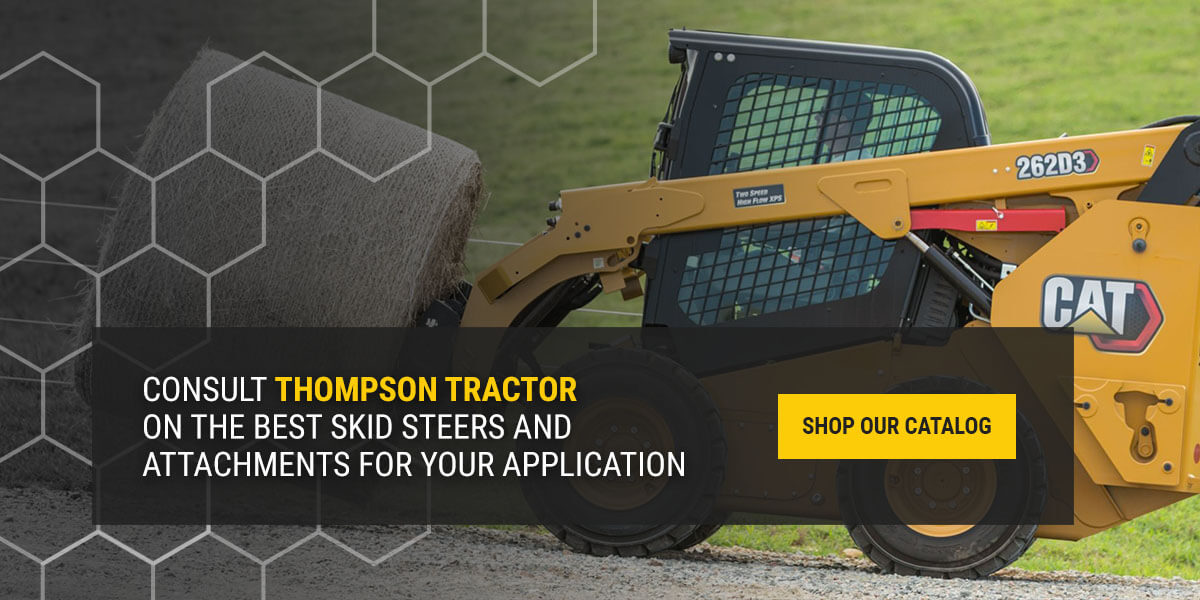
The skid steer loader is one of the most popular and multi-faceted pieces of machinery on the market — which, inevitably, means it’s also one of the most difficult to select.
Choosing a skid steer and the right skid steer for your exact job has been known to cause headaches for even seasoned experts. From auxiliary hydraulics to rated operating capacities to attachment types to lifts, sorting through skid steers can feel like sorting through a textbook of terms and technicalities.
Let’s cut through the noise to help determine what kind of skid steer you should buy. You’ll learn about the different types of skid steers and what you should look for when buying a skid steer.
How Skid Steer Loaders Have Evolved, Giving Owners More Choices Than Ever
A lot has changed since the first skid steer was built in the late 1950s. From a hand-fabricated prototype fashioned on a Minnesota turkey farm to the industrial-grade mechanical mules we know today, the skid steer loader has come a long way.
However, it’s this evolution that’s caused much of the confusion. While manufacturers nowadays distinguish models based on rated operating capacity, this isn’t the only variable to consider.
The evolution of the skid steer loader has brought with it several design and functionality changes that, today, offer unprecedented capabilities for owners and lessees:
- Controls: Many models have gradually moved from the traditional lever-and-pulley system to joystick controls. Top-of-the-line Caterpillar® skid steers also have electronic dashboards for highly accurate machine reads and maintenance.
- Lift: There are two types of skid steer lifting capacities: radial and vertical. Each has its own design, features, lift height, and more, described below. These will be key in making the right skid steer purchase.
- Size: Skid steer sizes vary in height and operating weight. The smallest can weigh less than 6,000 lbs, while the largest models exceed 8,000-9,000 lbs. A skid steer’s size and operating weight affect its mobility and safe operating capacity.
- Horsepower: Similar to size, skid steers come diversified based on horsepower. Small units generally have a horsepower performance under 50 hp. Medium units are between 50-70 hp, and large skid steers are over 70 hp.
- Amenities: Heating, air conditioning, adjustable seats, and noise reduction technology can be installed for cab comfort. Depending on how long you and your crew will use these machines, a unit or two with extra amenities makes the job more pleasant.
- Tracked vs. wheeled: Skid steer models come with a steel or rubber track system or a wheeled system. Tracked skid steers are also known as compact track loaders. The right option will depend on the need of your application because tracked and wheeled systems have unique benefits and drawbacks. For example, tracked skid steers can navigate rough terrain easily, while wheeled systems can maneuver through tight spaces or across long distances more efficiently.
Knowing What to Consider When Choosing a Skid Steer
Skid steers’ versatility means they can tackle a range of construction applications — just not every application. To help choose the best skid for your specific job, thoroughly research the following unit details:
1. Rated Operating Capacity
A skid steer’s rated operating capacity is how much load, or weight, it can carry without reaching its tipping point or causing dangerous load malfunctions. In simpler terms, it’s how much a skid steer can lift.
Rated operating capacities are not to be confused with operating weight, which is how much the piece of equipment itself weighs with a full tank of gas and an average-sized machine operator inside.
Rated operating capacities are critical to determining the right skid steer. As a generalization, higher operating capacities will handle more grueling loads and lift applications due to their higher-output engines and hydraulic systems.
2. Size and Weight
Depending on your core application, the size skid steer you need will vary. Small, medium, or large skid steer frames will meet demands while remaining mobile and controllable.
Frames are defined by a unit’s rated operating capacity and horsepower. According to the Associated Equipment Manufacturers (AEM), size and weight frames are broken down into three generic categories:
- Large Frames: 2,200+ lb.-minimum rated operating capacity, at least 70-hp.
- Medium Frames: 1,750-2,200 lb.-rated operating capacity, 50-70 hp.
- Small Frames: 1,550-1,750 lb.-rated operating capacity, around 50 hp.
There is a wide range of sizes to choose from, so you’ll want to carefully consider your options when choosing a skid steer for your applications. For example, you can keep the following points in mind:
- Operating capacity: In most cases, the operating capacity of a skid steer increases as the weight and size increase. If you need a higher operating capacity, you’ll likely need a bigger skid steer to ensure it can complete the necessary tasks at your worksite.
- Budget: Project budgets will significantly influence the size skid steer you can afford for your work. You can keep your project within your budget by choosing the smallest skid steer that still meets your needs. For example, if your project requires a skid steer with an operating capacity of 2,000 lbs, you can complete your tasks with a medium-frame skid steer and may not necessarily need a large-frame skid steer.
- Worksite dimensions and layout: The maneuverability of your job site will play a significant factor in which skid steer you should choose. If your job site has tight spaces and a lot of obstacles, a smaller skid steer may be best. However, if your worksite is wide open and requires a higher operating or lift capacity, a larger skid steer would be better suited to your worksite.
You can view our available models to better understand the best skid steer size and weight for your applications.
3. Terrain
Consider the terrain of the site or area you’ll be working. Generally speaking, skid steer loaders’ wheels function best on smooth, even, and relatively solid surfaces. They do not fare well in mud or continuously rocky terrain. This is a rule of thumb regardless of frame, rated capacity, lift type, or operating weight.
However, you can find compact track loaders to help you maneuver along uneven or muddy terrain. We discuss this equipment in more detail below.
4. Attachments
Attachments will be the next significant factor for your skid steer acquisition.
This requires a little foresight, as attachments are any extra tools or extensions you hook up to your skid steer to perform a particular task. Attachments are a cost-effective alternative to buying or renting additional single-use machinery, allowing you to execute various applications from the convenience of your skid steer cab.
However, it’s important to note that skid steer attachments need specific amounts of power, which only select machines can generate through their hydraulic flows.
5. Lift Type
As mentioned above, skid steers come with two different lift configurations: radial or vertical. This is the final major consideration you’ll need to make when picking a skid steer for your application since the two types carry different limitations:
- Vertical lifts are those designed for higher or taller load movements. They also carry a higher midpoint lift cycle reach, meaning they can access spaces other equipment can’t.
- Radial lift design is more compact and simple than its vertical cousin. It holds fewer internal moving parts and is ideal for load movements at or around ground level, such as digging dirt or shifting terrain.
Note that lift designs aren’t size-specific. You’ll find small, medium, and large-framed skid steers outfitted with each lift type. It’s more important to view lift capacity as part of how you need to move loads rather than roped into size. If you’re performing applications at or below eye level, industry experts say opt for radial machines, while if your load movements are predominantly above eye level, go for vertical.
6. Project Environment
The requirements of your project will play a central role when choosing a skid steer. Some of the essential factors from your job site that will help you choose the appropriate skid steer include:
- Project type: Your typical project types and requirements will influence the type of skid steer that best suits your job site. For example, construction sites usually need larger skid steers to accommodate lifting and power requirements, while landscaping companies often use smaller skid steers, as they’re more maneuverable than large machines.
- Work environment: Another factor to consider is the work environment. If you’re working on soft or muddy ground or uneven terrain, consider investing in a compact track loader instead. However, you can also choose a wheeled skid steer if working on hard, flat surfaces. You should also consider your work environment when choosing skid steers with different features. For example, if your operators are commonly working in the heat, you may want to choose a skid steer with air conditioning and a closed cab.
- Frequency of use: How often you need your skid steer will help you determine whether you need to buy new or used one or use a rental instead. If you’re using your skid steer for every project, and it’s one of the main machines you need to achieve your project goals, buying a new one may be the best investment. If you use a skid steer frequently but aren’t always necessary for your project, you can consider buying a high-quality used machine. Minimal use may be best suited to rentals.
Understanding the Difference Between Skid Steers and Compact Track Loaders
Remember how we mentioned skid steers don’t play nice with uneven or soft terrain?
This mechanical reality has led to an iteration of the skid steer known as the compact track loader — a piece of construction equipment that performs the same general tasks and functions as its predecessor but sits atop rotating tracks rather than wheels.
This gives the compact track loader a distinct terrain advantage. Unlike the skid steer, compact track loaders are designed to operate on difficult surfaces like sod, mud, rocks, sand, and snow. Wet and uneven surfaces are also less of a concern since the rotating base tracks maintain an uninterrupted glide rather than separate points of ground contact like wheels.
Other significant differences between skid steers and compact track loaders include:
- Stability: Because of their flat tracks, compact loaders will provide a more stable ride for operators sitting in the cab.
- Maintenance: The rubber tracks of compact units are prone to wear and tear more easily than wheels, especially on concrete, asphalt, and rocks. They are also more expensive to source and replace.
- Cost: Compact track loaders are more expensive to buy and rent up-front. When owning, you are responsible for rubber track maintenance and repairs. If renting, many companies will build the rubber wear-and-tear costs into the unit’s pricing, charging you accordingly.
Selecting the Right Skid Steer Loader for Each Application
You have the skid steer terminology, considerations, and unit details in your back pocket. Here’s where the fun begins: matching these skid steer unit characteristics to the actual job.
This goes beyond selecting the machine with the highest rated operating capacity or a skid steer touting the flashiest auxiliary hydraulics system. These things are essential, but they won’t make a match made in construction heaven.
Review the following popular skid steer applications below and see which best aligns with your need:
1. Site Development
Site development includes general landscaping, land clearing, earthwork, and paving. For operations like this without significant impediments, opt for mobile-forward skid steers that carry a radial lift. The mobility will ensure the unit easily maneuvers across all places on site, while the radial lift will be ideal for the kinds of groundwork at the heart of site development.
2. Digging
Any digging or excavation-centered application benefits from radial lifts. Once again, a radial-lift design’s movements and dexterity will better match those needed for bucket and digging attachment functionality. Plus, they complement these tools with robust and steady drawbar power.
Ensure your radial model for digging has a slightly higher hydraulic flow — somewhere near 60 hp should do just fine. These mid-grade flows are responsible for powering any necessary digging attachments, and you don’t want them to come up short while on the job.
3. Dozing
For dozing applications where pushing, leveling, and spreading ground materials is the day’s task, you’ll want a skid steer loader with a flexible yet strong mid-lift reach and plenty of horsepower to keep the job moving swiftly. Bigger is never necessarily better for skid steers, yet selecting one with a sizeable machine rated operating capacity, drawbar power, net power, and higher hydraulic flows covers your bases for large digging applications.
4. Backfilling
Radial lift designs typically afford better 360-degree visibility from the cab, plus a longer reach in front of the skid steer unit. In applications where visibility, horizontal reach, and mobility are needed — like those in backfilling — select radial designs with steady digging and drawbar functionality. The simplified configuration at the heart of a radial skid steer makes it the more practical choice for this application.
5. Material Handling
There are few construction jobs where material handling or stockpiling isn’t involved. From hauling rocks and broken concrete to soil, sod, sand, and so much more, a larger or heavier skid steer model will be in your best interest.
From a single machine, you can grade, scoop, transport, and dump physical debris, bolstered by a vertical lift, not a radial one. Depending on the nature of the materials, you may even want a high-flow machine that can handle saws, cutters, and other high-shock material-preparation attachments.
Material handling applications also require repeated lift-and-place motions, such as what comes with storing heavy pallets in a warehouse. These, too, are best accomplished with heavier models containing vertical lifts.
6. Loading
Vertical lifts generally afford a higher reach and can carry heavier loads than their radial counterparts. This further solidifies their importance for loading-centric applications, such as carrying and dumping materials onto trucks, flatbeds, and other construction equipment.
With this specific application, you’ll also want to prioritize a skid steer unit’s rated operating capacity, tipping loads, mobility, and stability since they all factor into how they port loads.
7. Demolition and Clean Up
Interestingly enough, some of the most straightforward applications can require some of the highest and most-intense output machines. In no way is this truer than for jobs like snow plowing and construction demolition.
The jobs may seem simple, but the engine strength and auxiliary hydraulic systems needed to perform these duties and power their essential attachments are only found in some of the largest skid steer models. These machines have superior rated operating capacities in the 2,000 hp range and are outfitted with the most durable vertical lift-force designs.
Choosing the Right Skid Steer Loader Attachments
Choosing the proper attachment for your skid steer loader rests on two key variables: hydraulic flow and engine horsepower.
To simplify things, skid steer auxiliary hydraulics and engine outputs are a large part of frame classifications — meaning to best match attachments with a unit, you can generally rely on a frame size-to-attachment formula:
1. Small Frames (1,550-1,750 lb. rated operating capacity/~50 hp)
Small-frame skid steers intuitively feature simplified or more basic hydraulic systems. However, don’t assume they can’t power attachments just because they’re the simplest.
Many skid steer loaders with rated operating capacities in the 1,600 lb. range and hydraulic flows in the 50-59 hp range can support the following digging, excavation, and filling tools:
- A range of dozer blades and buckets
- Backhoes
- Augers
- Small trenchers
- Hydraulic breakers
- Skid steer grapples
2. Medium Frames (1,750-2,200 lb. rated operating capacity/50-70 hp)
With their dynamic balance of rated operating power, net engine power, breakout forces, and steady hydraulic flows, medium-framed skid steers make an ideal companion to most attachments. Particularly for skid steers at or near the 70 hp output, these frames can sufficiently power attachments at their optimal performance range while still running efficiently.
Overall, the list of attachments that work well with medium-sized skid steers is extensive. On top of powering the same attachments a small frame can (augers, trenchers, etc.), they will also handle the following:
- Pallet forks
- Bale spears
- Industrial brooms
- Standard trenchers
- Standard saws
- Mini excavators
3. Large Frames (2,200 lb. rated operating capacity/70+ hp)
With the highest operating capacities and strongest hydraulic flows, large-framed skid steers will power the most attachments.
Those looking for the best alignment rather than blanket solutions, however, can specifically pair skid steer models with the hydraulic flows demanded by specific attachments. These flow demands can be broken down into the following three cases that — if looking for a single and not broad match — will even more accurately pinpoint the exact features to look for in your skid steer base:
- High Auxiliary Hydraulic Flow: The logic of hydraulic flows goes like this: The higher the flow, the more power can be delivered via the loader to the attachment. Attachments requiring high flows experience high rates of in-use motion, such as cold planers, stump or tree grinders, wheel saws, forestry cutters, and certain industrial trenchers. Select a high-hydraulic flow model if frequently using any of these attachments.
- High Rated Operating Capacity Applications: Similar to hydraulic flows, higher-rated operating capacities will power more output-intensive applications. For those using snow blowers and snowplow attachments, you will likely need a large-framed, vertical-lift skid steer.
- High Force/Stress Applications: Jobs that exert high shock or vibration onto the skid steer need a stronger, more durable unit. Attachments that tend to do so include mulchers, drills, cold planers, and rock saws. Opt for large-frame radial lift machines, as their mechanical makeup contains fewer moving parts and is less likely to incur damage due to shock vibrations.
Consult Thompson Tractor on the Best Skid Steers and Attachments for Your Application
Thompson Tractor has provided premium skid steer loader sales, support, and services for over 60 years throughout Alabama and Northern Florida. Our team can help you find the right skid steer loader to meet the needs of your application, boosting your efficiency and productivity. Shop our catalog of new and used Cat skid steer loaders, or get in touch with a representative today.



